Publication
auri Research Brief
Where are children's play facilities installed, and how many?
- No.84
- 2023.05.09
- Hit 4978
- Lee, Sangmin Senior Research Fellow
- Song, Yunjeong Assistant Research Fellow
- Kang, Hyunmi Associate Research Fellow
The right to play, which is essential for children's healthy, safe and happy development, can be exercised in spaces designed for play, specifically play facilities. If children's play facilities are provided unequally depending on their locations, it is a problem that society must address. To solve the issue of unequal access to play opportunities, easily accessible play facilities should be created and continuously managed in public areas of neighborhoods where children reside.
Currently, there is no official definition of a “children's playground” in Korean law. The Act on the Safety Control of Children's Play Facilities refers to a facility where children's play equipment is installed as a “children's play facility.” This study examines the installation of children's play facilities1) and analyzes the differences in the number of children's play facilities per local government, differences across regions, and the proportion of children's play facilities in residential areas (apartment complexes).
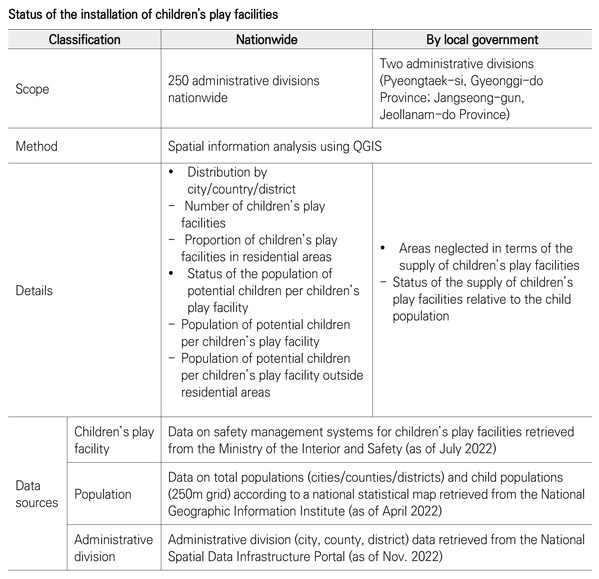
Where are children's play facilities installed?
As of the end of 2021, there are 78,351 children's play facilities nationwide. Among them, 2,358 facilities were installed in 2021, with 52% installed in residential areas, 14% in urban parks, and 11% in child care centers. Indoor children's play facilities account for 6% (4,441 facilities), among which 27% are located in food service establishments, 19% in children's play businesses, 17% in child care centers, and 11% in residential areas.
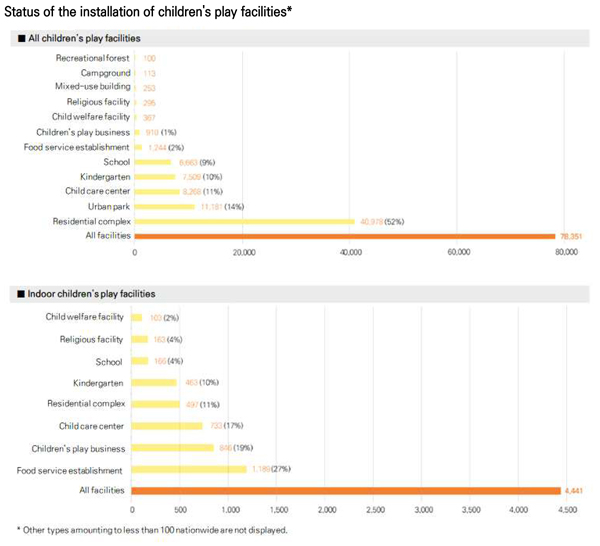
Before 1990, children's play facilities were mainly installed in schools or residential areas. They increased rapidly in number after 1990, particularly between 2010 and 2014. Since 2010, they began to be installed in more diverse locations, such as food service establishments, children's play businesses, and indoor areas.
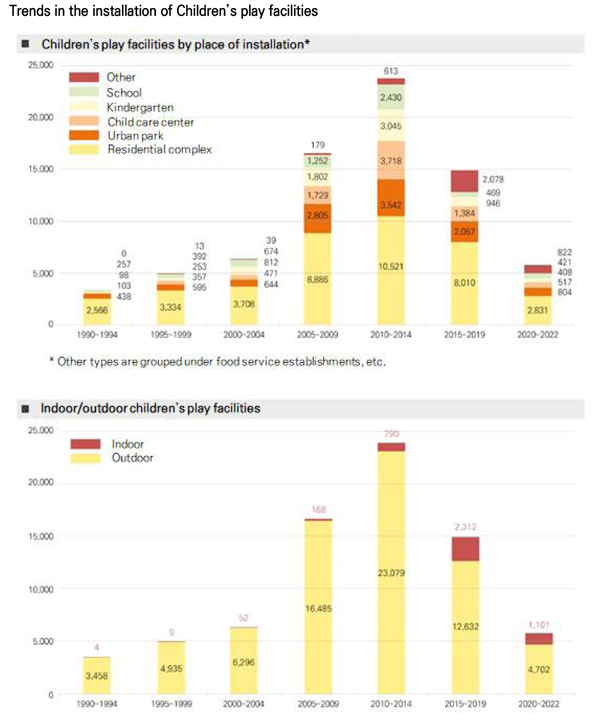
How many children’s play facilities are there by local government?
On average, local governments across the country have 314 (median of 267) children’s play facilities, which are concentrated in special and metropolitan cities. The city with the highest number of children’s play facilities is Hwaseong (1,695) in Gyeonggi-do Province, and the area with the fewest is Ulleung-gun (15) in Gyeongsangbuk-do Province. Those with a higher number of children’s play facilities are usually located in metropolitan areas, while those with fewer facilities are in Gyeongsangbuk-do Province.
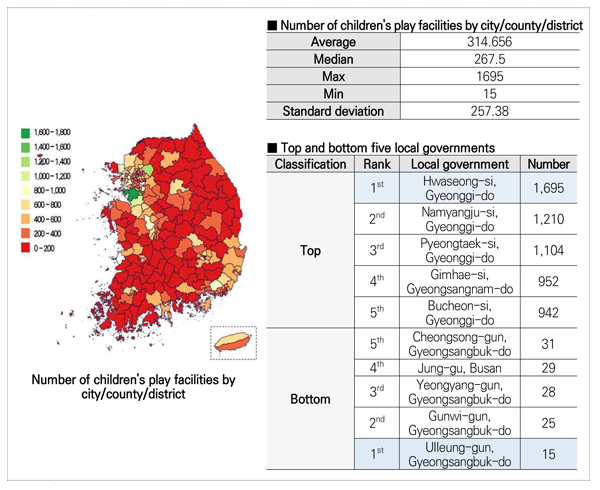
On average, the proportion of children's play facilities installed in residential areas among all such facilities nationwide amounts to 42.79%. The local government with the highest proportion of children's play facilities installed in residential areas is Suji-gu (67.09%), Yongin-si, Gyeonggi-do Province, while the lowest is Sinan-gun (0%) in Jeollanam-do Province. Local governments with a higher proportion of children's play facilities in residential areas are mostly located in metropolitan areas, while those with lower proportions are in Gyeongsangbuk-do Province.
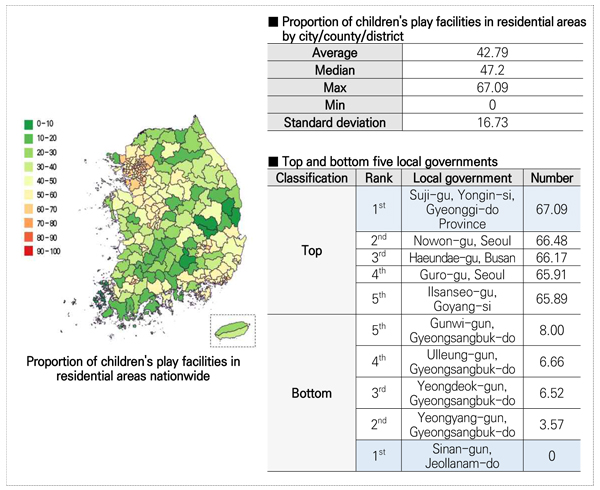
How large is the child population per children's play facility?
The estimated child population per children's play facility is 69.96 on average nationwide, and Gwangjin-gu in Seoul has the highest potential number of children per facility at 127.8. The lowest is Ongjin-gun in Incheon with 23.4 children. The potential child populations per facility are higher in metropolitan areas and lower in rural areas in Gangwon-do Province.
The potential child population per children's play facility in non-residential areas is 139.61 children on average, nearly twice as much as when including facilities in residential areas. Seoul's Gangdong-gu (303.7 children), Songpa-gu (296 children) and Seocho-gu (288.7 children) had the highest potential child population per facility in non-residential areas, while Ongjin-gun (29.8 children) in Incheon had the lowest. The potential child population per facility is higher in densely populated areas such as special and metropolitan cities.2)
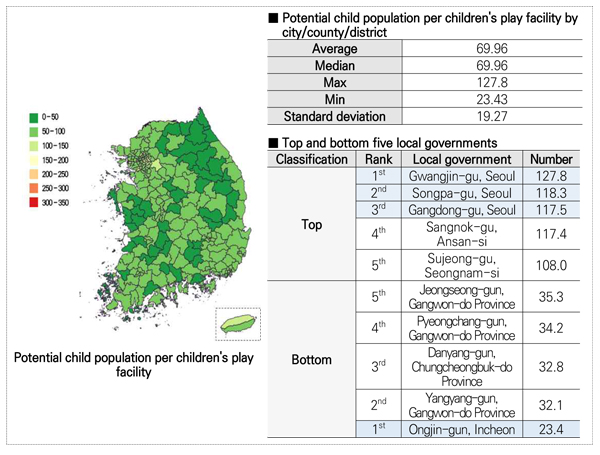
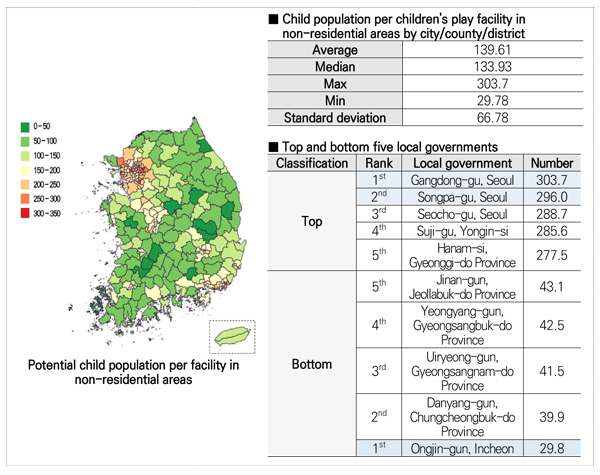
Where are the residential areas that lack children's play facilities?
This study conducted a detailed analysis of local governments corresponding to the national average and median (69) values for child population per children's play facility and those having insufficient children's play facilities (Pyeongtaek-si, Gyeonggi-do Province, Jangseong-gun, Jeollanam-do Province). Children's play facilities were divided into facilities in residential areas and facilities in non-residential areas, and the supply of facilities relative to the population was examined based on an analysis of child populations (within 250m×250m) and the scope of the supply of children's play facilities (250m radius).3)
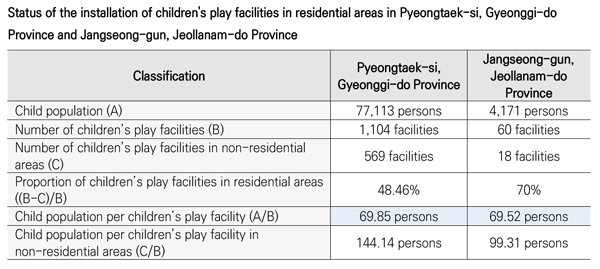
Children's play facilities are mostly concentrated in areas with dense child populations. However, as shown on the map below, Hyeondeok-myeon, Paengseong-eup, Seotan-myeon and Cheongbuk-eup in Pyeongtaek-si and Bugi-myeon, Bukha-myeon, Seosam-myeon, Nam-myeon, and Jinwon-myeon in Jangseong-gun do not have children's play facilities despite the presence of children. In particular, there are almost no children's play facilities available within a 250-meter radius of residential areas of children in Jinwon-myeon, Jangseong-gun. While the region overall does not have an insufficient number of children's play facilities relative to the child population, it is difficult for children actually to use them due to the facilities being located at some distance away from their homes.
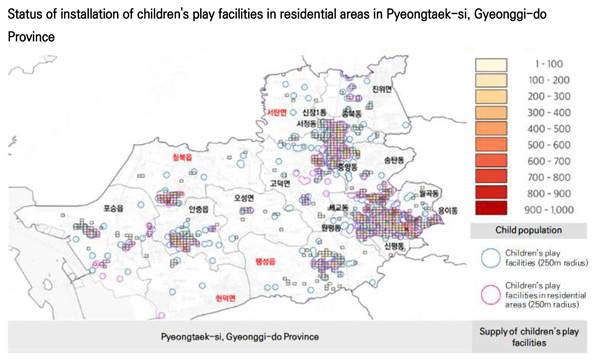
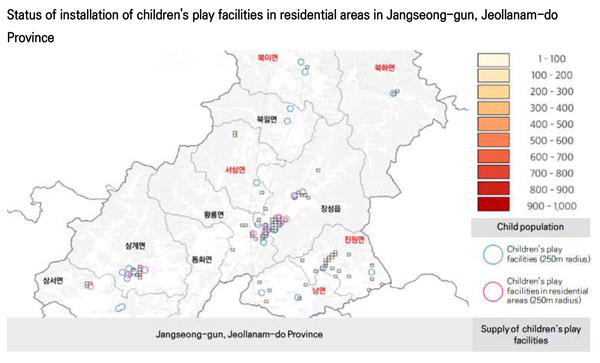
For neighborhoods or towns with a dense child population, most children's play facilities are installed within a 250-meter radius of the residential areas home to the children. Most of these facilities are located in housing complexes. For Segyo-dong and Jungang-dong in Pyeongtaek-si and Jangseong-eup in Jangseong-gun, areas without children's play facilities have increased if excluding those in residential areas, meaning that a higher number of children are unable to use such facilities near their residential areas.
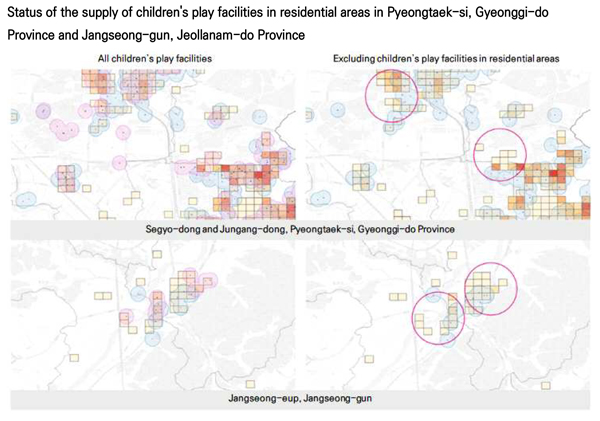
In densely populated areas of Seojeong-dong, Jungang-dong, Wonpyeong-dong and Sinpyeong-dong in Pyeongtaek-si, there are many children’s play facilities within a 250-meter radius of residential areas, providing children with various play opportunities. However, the fewer play facilities in Jangseong-gun indicates that children have more limited opportunities to play.
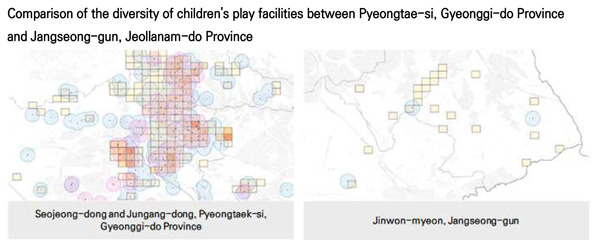
The analysis revealed that some children's play facilities have a low possibility of actual use due to their location. A mismatch between users and facility locations was observed in Cheongbuk-eup, Pyeongtaek-si and Bukil-myeong, Jangseong-gun.
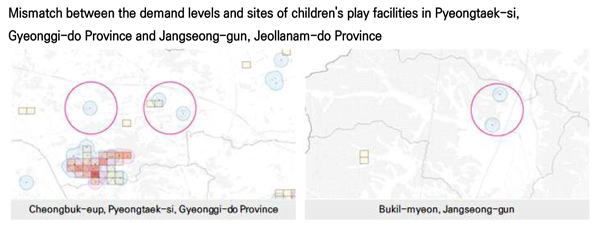
Children should have easy access to various children’s play facilities near their homes.
Children’s play facilities are concentrated in densely populated areas, particularly in special and metropolitan cities. The average number of children’s play facilities per local government is 314. The average potential child population per children’s play facility is 69.96, and each facility is being used by an average of 139.61 children if excluding facilities installed in residential areas.
In neighborhoods and towns, children’s play facilities are installed within a 250-meter radius of residential areas, but areas lacking in children’s play facilities have increased if excluding those in residential areas. Townships are expected to face difficulties in securing diverse play opportunities due to their limited number of facilities. Even with an adequate number of facilities relative to the child population, there may be areas with poor access if the facilities are being located beyond a reasonable walking distance.
In other words, areas with high population densities and large-scale housing complexes provide a variety of play opportunities, while those with low population densities and existing residential areas have relatively fewer play facilities, thus limiting play opportunities for children. Furthermore, we can expect a significant difference in the quality of facilities between newly built apartments and existing residential areas.
This study examined where and how many children’s play facilities are installed in Korea, cited as a country that deprives children of the right to play according to the UN Committee on the Rights of the Child (Kim Myeong-Sun, 2017, p.7). Children’s playgrounds, a common site of everyday life, are essential for securing children’s play opportunities and serving as part of a spatial foundation for raising children in a safe, healthy manner. From this perspective, children’s playgrounds are important public infrastructure for society, and society has a duty to provide an environment where children can enjoy easy, diverse access to playgrounds without discrimination.
1) An indoor or outdoor playground where children's play facilities (swings, slides, aerial facilities, or rotating facilities designed for children's play) are installed pursuant to Article 2 (2) of the Act on the Safety Control of Children's Play Facilities
2) The top 50 areas belong to metropolitan and special cities, with the exception of Gyeryong-si, Chungcheongnam-do Province (19th), Seobuk-gu, Cheonan-si (26th), and Seongsan-gu, Changwon-si (47th)
3) 250-meter radius applied as installation criteria of children's parks among urban parks
- Kim Myeong-Sun. (2017). A Study for the Establishment of Children's Play Policies. Ministry of Health and Welfare.
- Lee Sang-Min, Gang Hyeong-Mi, Song Yun-Jeong, and Kim Su-In. (2022). A Study on Improvement of Laws for Better Children's Playgrounds. Presidential Commission on Architecture Policy.
